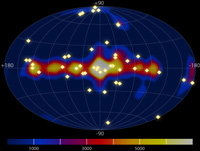http://www.spacedaily.com/reports/A_Bri ... s_999.html
Thus far LIGO et al have detected precisely squat in terms of GRBs.These bursts seemed impossibly powerful: to appear so bright from so very far away, they must vastly outshine entire galaxies containing hundreds of billions of stars.
These explosions, called gamma ray bursts (GRBs), are by far the brightest and most energetic phenomena in the known universe, second only to the Big Bang itself. Scientists were at a loss to imagine what could possibly cause them.
Astronomers now know what the longer-lasting GRBs are: the collapse and explosion of an ultra-massive star to form a black hole at its core, an explanation first proposed by Stan Woosley of the University of California in San Diego. But there's a second category of GRBs that still remains a mystery.
"The short-lived ones are very poorly understood ..."
[...]
"We have had good evidence since the 1990s that the short bursts and long bursts were different classes," Gehrels explains.
"It had to do with their gamma ray properties." Not only do the short bursts last less than about 2 seconds, the spectrum of light they emit is distinct. Gamma rays from short bursts lean toward the high-energy end of the spectrum, while long GRBs emit lower-energy gamma rays.
The differences were highlighted in 2005 when, for the first time, telescopes caught sight of short GRB afterglows. The fading debris contained no supernova, arguing against the collapse of a massive star.
[...]
Ultimately, the cause of short bursts is unknown. But scientists do have some good guesses.
The leading theory is that these bursts are extremely violent collisions between pairs of neutron stars.
[...]
So how could scientists know whether this explanation is true?
One way could be to detect gravitational waves. Before the two neutron stars collide, they would orbit each other as a binary system. Because their fields of gravity are so intense, the stars ought to send waves rippling outward in the fabric of space-time: gravitational waves.
[...]
Could it be that GRBs are simply high energy and low energy discharges? "Not only do the short bursts last less than about 2 seconds, the spectrum of light they emit is distinct. Gamma rays from short bursts lean toward the high-energy end of the spectrum, while long GRBs emit lower-energy gamma rays."
Reminiscent of Bernard Vonnegut's paper on vortex stabilization of a high voltage discharge.
(Stabilization of a High-Voltage Discharge by a Vortex.)
http://adsabs.harvard.edu/abs/1960JAtS...17..468V
Granted, the EM waves he was measuring were radio frequency waves. But the results were still interesting. In an arc it was relatively radio noisy, but could only jump a smaller gap. By spinning up the spark gap with fans (I seem to recall that's what he used), the discharge was able to traverse a large spark gap but hopped down from arc mode to glow mode and the radio noise died off as well. Could it be that GRBs are from an equivalent phenomenon? IE, a shorter, faster spark will tend to be much noisier, whereas a more strung out, slower discharge would be "quieter." Don't know if this is a reasonable explanation or not? Just a first crack at it.
I also recall a prior discussion regarding TGF (Terrestrial Gamma-ray Flashes), and the incidence seemed to be spatially located in regions undergoing heavy lightning activity:
(RHESSI Science Nugget: Terrestrial gamma-ray flashes)
http://sprg.ssl.berkeley.edu/~tohban/nu ... icle_id=32
Hmm, makes one take pause if only briefly, no? Does this give us a clue? Many upper atmospheric phenomena are diffuse glow mode effects. Lighting is a rather high-energy spatially confined process (z-pinched, arc mode plasma, etc.)... That TGFs come from lightning rather than auroras or difuse upper-atmospheric processes is perhaps not entirely to be unexpected?All of these lines of study seem to be pointing to a common conclusion: that TGFs are not associated primarily with the exotic sprites, elves, and blue jets, which occur at very high altitudes, but with lightning itself.
Regards,
~Michael Gmirkin
